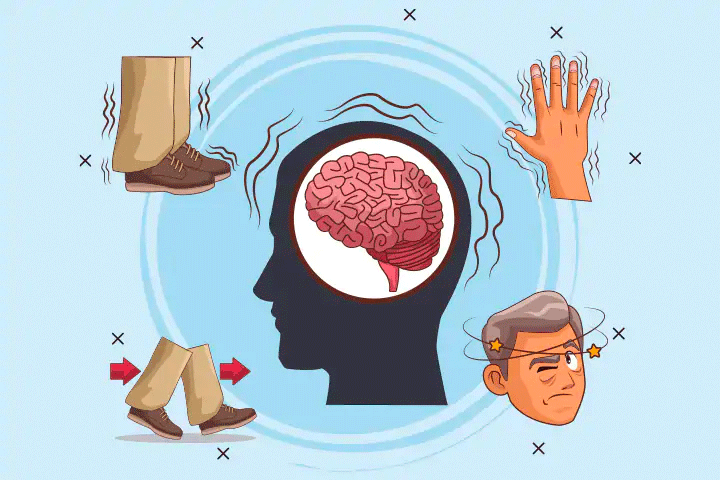

A 45-year-old Israeli man was diagnosed with probable Parkinson’s disease several months after being hospitalized with SARS-CoV-2 infection.
The Ashkenazi Jewish patient had no family history of Parkinson’s disease and had not been exposed to neurotoxins or recreational drugs, said Mikhal Cohen, MD, PhD, of the Hebrew University of Jerusalem in Israel, and co-authors, in a case report published in The Lancet Neurology.
“The mechanism that led to the presumed degeneration of nigrostriatal dopaminergic nerve terminals is unclear,” the researchers said. “Perhaps a susceptible genetic makeup made our patient vulnerable to immunologically mediated mitochondrial injury and neuronal oxidative stress.”
“Another hypothesis could be that the virus causes inflammation via microglial activation, contributing to protein aggregation and neurodegeneration. However, the short time interval between the acute infection and the parkinsonian symptoms makes this hypothesis unlikely,” the team added.

The case serves as a real-life example of theories postulated about viruses like SARS-CoV-2 and the risk of Parkinson’s disease, noted K. Ray Chaudhuri, MD, DSc, of King’s College London in England, who wasn’t involved with the case.
“Historically, the influenza epidemic of 1918 was associated with post-encephalitic parkinsonism,” Chaudhuri told MedPage Today. “HIV, another RNA virus like COVID-19, has also been associated with basal ganglia damage.”
The patient was hospitalized on March 17 for dry cough and muscle pain and tested positive for SARS-CoV-2 on admission, the researchers reported. A few days before being hospitalized, he noticed a loss of smell. His previous medical history included hypertension and asthma.
In the hospital, the patient had fatigue, shortness of breath, and chest pain, but no fever. He was treated for 3 days — mostly with salbutamol for mild asthma symptoms, with no need for systemic drugs, oxygen, or ventilation — and then isolated on March 20 in a COVID-19 facility.
During the 3-week isolation period, the patient’s handwriting became less readable. He had difficulty speaking and typing text on his mobile phone and experienced tremor episodes in his right hand. He continued to have these symptoms at home and eventually was admitted to the neurology department of Shaare Zedek Medical Center in Jerusalem, about 2 months after his initial positive COVID-19 test.
There, he had reduced facial expression and soft speech, moderate cogwheel rigidity in his neck and right arm, and moderate bradykinesia in his right extremities. Symptoms were milder on his left side. His gait was slow, with no right arm swing, and he showed no cognitive decline.
Cerebrospinal fluid (CSF) showed six white blood cells (83% mononuclear cells), with normal glucose and protein. Anti-SARS-CoV-2 immunoglobulin G was seen in serum but not CSF, and CSF was negative for SARS-CoV-2. CSF and serum also were negative for common neuronal antibodies.
PET imaging showed decreased 18F-fluorodopa uptake in both putamens — more apparent on the left side. Genetic testing for LRRK2 mutations and full sequencing of GBA variants were negative, as were tests for other genes relating to Parkinson’s. (In Ashkenazi-Jewish people with Parkinson’s disease, about a third are carriers of either a GBA or an LRRK2 mutation.)
The patient was diagnosed with parkinsonism, based on Movement Disorders Society Unified Parkinson’s Disease Rating Scale criteria of probable Parkinson’s disease, and treated with extended-release pramipexole (Mirapex), which led to quick improvement.
New symptoms emerged during the 9 days of his second hospitalization, including tremor in both legs, more on the right side than the left. At discharge, he still had unreadable handwriting, bradykinesia, and cogwheel rigidity, mostly on the right side. A 5-day high-dose course of methylprednisolone had no consistent effect. In a follow-up visit on June 29, he was treated with biperiden, which improved his tremor.
One issue to consider is that there may no relationship between the actual virus and Parkinson’s disease. “COVID-19 infection may have been a stressor that brings previously subtle, unrecognized symptoms to a point of awareness,” noted Alberto Espay, MD, MSc, of the University of Cincinnati, who was not involved with the case.
“Many people with Parkinson’s disease count their time of onset the phase immediately recovering from a major stressor, such as a surgery or a motor vehicle accident,” Espay told MedPage Today. “But the symptoms that became eventually recognized as parkinsonian had been present before — with the wisdom of hindsight, often by the recollection of close family members — to such a mild extent as to have evaded attention,” he explained.
“It’s not that those exposures caused Parkinson’s but, rather they acted as precipitants, exacerbating subtle Parkinson’s symptoms to a threshold of severity making them noticeable for the first time to patients and physicians,” Espay said.
“The temporal association between the episode of SARS-CoV-2 infection and parkinsonian symptoms, which appeared during the acute infection, is intriguing,” Cohen and co-authors observed.
Before the patient’s admission to the neurology department, he had tested negative for SARS-CoV-2 on two occasions; he then was found positive for antibodies in serum, but negative in CSF, they noted. “Nonetheless, we cannot exclude the possibility that SARS-CoV-2 entered the central nervous system, particularly in view of the olfactory involvement and borderline pleocytosis.”